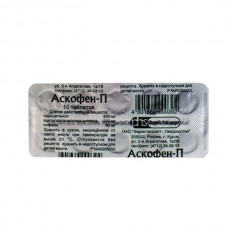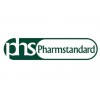Expiration date: 03/2026
International name: Acetylsalicylic acid+Paracetamol+Caffeine (Acetylsalicylic acid+Paracetamol+Caffeine)
Group affiliation: non-narcotic Analgesic remedy
Description of the active substance (INN): Acetylsalicylic acid+Paracetamol+Caffeine
Dosage form:
granules for solution preparation for oral administration, capsules, tablets
Pharmacological action:
A combination drug. ASC has antipyretic and anti-inflammatory effects, reduces pain, especially caused by inflammation, as well as moderately inhibits platelet aggregation and thrombus formation, improves microcirculation in the inflammation. Caffeine increases the reflex excitability of the spinal cord, stimulates the respiratory and vasomotor centers, dilates blood vessels in skeletal muscle, brain, heart, kidneys and decreases aggregation of thrombocytes, decreases drowsiness, the feeling of tiredness, increases mental and physical performance. In this combination the caffeine in a small dose almost has no stimulating action on the Central nervous system, however, contributes to the normalization of tone of cerebral vessels and accelerate blood circulation. Paracetamol has analgesic, antipyretic and extremely weak anti-inflammatory effect because of its influence on the thermoregulation center in the hypothalamus and mild ability to inhibit Pg synthesis in peripheral tissues.
Indications:
Pain mild and moderate symptoms (various origins): headache, migraine, toothache, neuralgia, myalgia, arthralgia, algomenorrhea. Feverish syndrome with colds and flu.
Contraindications:
Hypersensitivity, erosivno-azwenne shock syndrome (in the acute phase), gastro-intestinal bleeding, "aspirin" asthma, hemophilia, hemorrhagic diathesis, hypoprothrombinemia, portal hypertension, beriberi K, renal failure, pregnancy (I and III trimester), lactation, the deficit glukozo-6-fosfatdegidrogenaza, severe hypertension, severe coronary artery disease, glaucoma, anxiety, sleep disorders, surgical intervention, accompanied by bleeding, children's age (under 15 years - the risk of Reye's syndrome in children with hyperthermia on a background of viral diseases).C caution. Gout, liver disease.
Side effects:
Gastralgia, nausea, vomiting, hepatotoxicity, nephrotoxicity, erosive and ulcerative lesions of the gastrointestinal tract, allergic reactions, tachycardia, increased blood pressure, bronchospasm. With prolonged use - dizziness, headache, blurred vision, tinnitus, decrease platelet aggregation, hypocoagulation, hemorrhagic syndrome (nosebleeds, bleeding gums, purpura, etc.), damage to the kidneys with papillary necrosis, deafness, malignant exudative erythema (Stevens-Johnson syndrome), toxic epidermal necrolysis (Lyell's syndrome), Reye's syndrome in children (or hyperpyrexia, metabolic acidosis, abnormalities of the nervous system and psyche, vomiting, liver function abnormalities). Overdose. Symptoms (due to ASA): for mild intoxication - nausea, vomiting, gastralgia, dizziness, ringing in the ears, severe intoxication - lethargy, drowsiness, collapse, convulsions, bronchospasm, difficulty breathing, anuria, bleeding. Initially, the Central hyperventilation leads to respiratory alkalosis (shortness of breath, dyspnea, cyanosis, sweating). With the increasing intoxication progressive paralysis of respiration and uncoupling of oxidative phosphorylation cause respiratory acidosis. Treatment: constant control of CBS and electrolyte balance, depending on the state of metabolism - the introduction of sodium bicarbonate, sodium citrate or sodium lactate. Increasing the reserve alkalinity increases the excretion of ASA by alkalinization of urine.
Method of application and dose:
Inside (during or after eating), 1 tablet every 4 hours, when pain syndrome - 1-2 tablets, average daily dose - 3-4 tablets, the maximum daily dose - 8 tablets. The course of treatment - 7-10 days. The drug should not be taken more than 5 days as an analgesic drugs and more than 3 days and antipyretic (without assignment and supervision). Dr. dosage and patterns of use are established by the doctor.
Special instructions:
Children are not allowed to assign drugs containing ASA, as in the case of viral infection, they are able to increase the risk of Reye's syndrome. Symptoms of Reye's syndrome are prolonged vomiting, acute encephalopathy, enlarged liver. Prolonged use of the drug requires monitoring of peripheral blood and functional state of the liver. Since ASA slows the clotting of blood, the patient if he has surgery, must inform the doctor about the drug. Patients with hypersensitivity or asthmatic reactions to salicylates or their derivatives ask can only be assigned with observance of special precautionary measures (emergency assistance). ASA in low doses reduces the excretion of uric acid. In patients with a relevant predisposition, it may in some cases provoke an attack of gout. During treatment should abandon the use of ethanol (increased risk of gastrointestinal bleeding). Ask teratogenic effect, when used in the I trimester leads to malformations - cleft palate, in the third trimester to the inhibition of labor (inhibition of Pg synthesis) closure of the ductus arteriosus in the fetus that causes the pulmonary vascular hyperplasia and hypertension in the vessels of the lesser circulation. Excreted in breast milk, which increases the risk of bleeding in a child due to dysfunction of platelets.
Interaction:
Enhances the action of heparin, indirect anticoagulants, reserpine, steroid hormones and hypoglycemic drugs. Simultaneous administration with other NSAIDs, methotrexate increases the risk of side effects. Reduces the effectiveness of spironolactone, furosemide, antihypertensive drugs, as well as protivopodagricakih drugs that promote uric acid excretion. Barbiturates, rifampicin, salicylamide, antiepileptic drugs and other stimulants microsomal oxidation contribute to the formation of toxic metabolites of paracetamol that affect liver function. Metoclopramide accelerates the absorption of paracetamol. Under the influence of paracetamol withdrawal times chloramphenicol increased 5 times. In repeated dose acetaminophen may increase the effects of anticoagulants (derivatives of decumarine). Simultaneous intake of paracetamol and ethanol increases the risk of hepatotoxic effects. Caffeine speeds up the absorption of ergotamine.
The description of the drug Askofen-P is not intended to assign treatment without a doctor.



